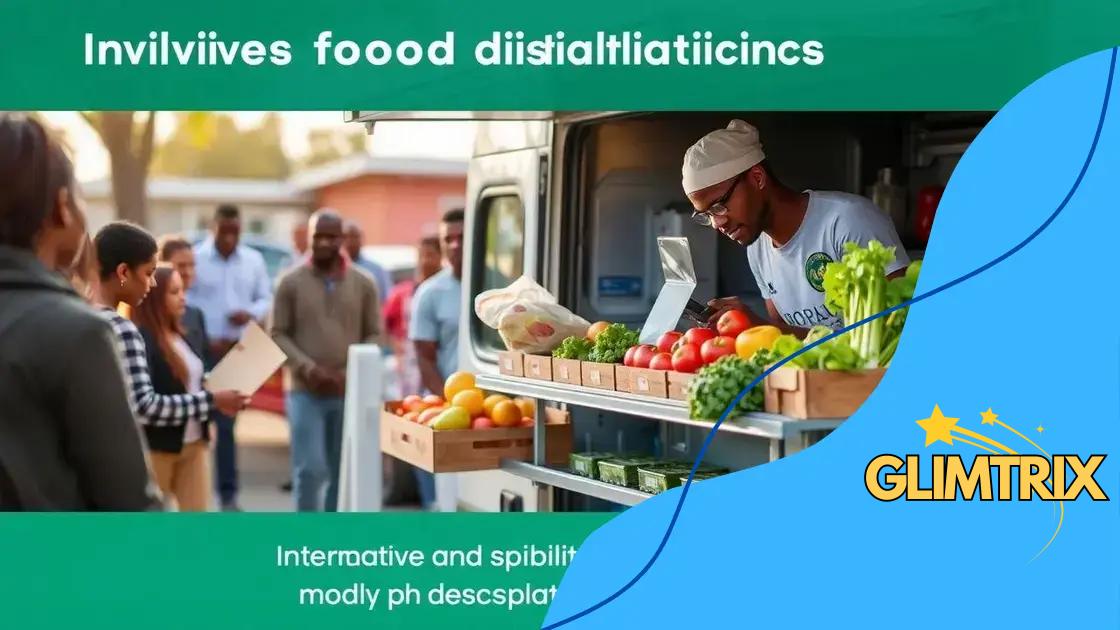Food assistance programs adapting post-pandemic

Food assistance programs adapting post-pandemic focus on sustainability, technology integration, and community involvement to effectively meet the rising needs of food insecurity in diverse populations.
Food assistance programs adapting post-pandemic are crucial as communities navigate new challenges. Have you considered how these programs have shifted to meet emerging needs? Let’s dive into their evolution.
The evolution of food assistance programs
The evolution of food assistance programs has been a response to changing needs in our communities, especially post-pandemic. These programs have adapted to ensure that no one goes hungry, reflecting our collective resilience.
Historical Background
In the past, food assistance was primarily focused on emergency relief. Today, however, these programs incorporate long-term strategies that emphasize food security. Initiatives have grown from merely distributing food to addressing the root causes of hunger.
Key Changes in Food Assistance
One notable shift is the use of technology. Many programs now utilize online platforms and apps to efficiently distribute food, making it easier for families to access the help they need.
- Technology allows for quicker response times.
- Online applications help streamline the enrollment process.
- Data-driven approaches improve service delivery.
Furthermore, collaboration with local farmers and markets has expanded. This not only supports local economies but also ensures that food is fresh and nutritious.
Inclusive Practices
Inclusivity has become a cornerstone of modern programs. By actively seeking to engage diverse populations, food assistance initiatives ensure that all community members receive support. This might include programs specifically designed for immigrants, seniors, or families with children.
As we move forward, the emphasis is on sustainability too. Many organizations are working to promote local food systems while reducing waste. By doing so, they’re not just feeding people; they’re building a healthier and more resilient food ecosystem.
Challenges faced during the pandemic
The challenges faced during the pandemic significantly impacted food assistance programs. As COVID-19 spread, many families found themselves in crisis, needing help more than ever.
Increased Demand for Services
With sudden job losses and economic instability, food assistance programs saw a surge in clients. Organizations were challenged to meet this increased demand quickly and effectively. Many had to adapt their delivery methods to ensure safety.
- Drive-thru food distributions became more common.
- Online registration simplified the intake process.
- Partnerships with local businesses helped expand resources.
Many programs also faced shortages of food supplies and funding. Donations dropped even as the need grew, leading to tough choices about how to allocate resources. Some organizations had to limit distribution days or cut back on the types of food being offered.
Health and Safety Concerns
Health protocols were another challenge. Programs had to quickly incorporate safety measures to protect both clients and volunteers. Social distancing and mask mandates complicated traditional distribution models.
Communication became crucial. Programs needed to keep the community informed about changes, using social media platforms and local news to spread the word. These shifts highlighted the importance of adaptability in times of crisis.
Finally, the mental health challenges experienced by many affected individuals cannot be overlooked. Food insecurity often led to increased stress and anxiety, making it vital for assistance programs to offer compassionate support.
Innovative strategies for food distribution

Innovative strategies for food distribution have emerged as vital responses to the challenges faced by communities during the pandemic. These strategies not only improve access but also enhance the efficiency of food assistance programs.
Technology Integration
One key strategy is the integration of technology in food distribution. Many organizations have adopted online platforms to streamline the process of ordering and receiving food. This shift allows families to access resources from the safety of their homes.
- Mobile apps enable users to check food availability.
- Websites provide updates on distribution schedules.
- Text messaging systems send alerts for reminder notifications.
By embracing these tools, food assistance programs can reach more people effectively.
Partnership Development
Another innovative approach is developing strong partnerships with local businesses, farms, and organizations. These collaborations help maximize resources and extend the reach of food programs. Through joint efforts, organizations can combine efforts in fundraising and resource sharing, significantly increasing support.
Community involvement is encouraged through volunteer opportunities. Engaging local residents fosters a sense of ownership and connection to the food assistance initiatives.
Moreover, utilizing mobile food pantries has become a popular way to reach underserved areas. These pantries travel to specific neighborhoods, making food distribution more accessible to those in need.
Finally, emphasis on fresh, nutritious food has led to increased collaborations with local farmers. This approach not only supports local agriculture but also promotes healthier eating habits among program participants.
Community involvement and support
Community involvement and support play a crucial role in the success of food assistance programs. When local residents come together, they can create a powerful network that helps families in need.
Volunteer Opportunities
One way communities can support food assistance is through volunteering. Many programs rely on dedicated volunteers to help with food sorting, packing, and distribution. This hands-on work not only provides essential services but also fosters a sense of community.
- Volunteers can help run food drives.
- They can distribute food at local events.
- Individuals can assist in administrative tasks.
By creating opportunities for residents to volunteer, programs can build strong relationships and encourage more people to get involved.
Local Partnerships
Building partnerships with local businesses, schools, and religious organizations can significantly enhance the reach of food assistance efforts. These partnerships can lead to greater resource sharing, including funding and food donations.
For instance, a local grocery store might donate items nearing their expiration date rather than discarding them. Schools can host food drives, while churches can provide volunteers and meeting spaces.
Community events also play a vital role in increasing awareness. Organizing workshops and informational sessions about food assistance ensures that more families know how to access these critical services.
Additionally, engaging with local leaders can amplify efforts. When community leaders endorse food assistance programs, they can attract more attention and resources from wider audiences.
Future outlook for food assistance initiatives
The future outlook for food assistance initiatives suggests a transformation in how communities address food insecurity. As the landscape of need changes, so too do the strategies employed to meet it.
Emphasis on Sustainability
One major trend is the growing focus on sustainability. Future programs are likely to prioritize environmentally friendly practices. This includes sourcing food locally and reducing waste in the distribution process. Communities are becoming aware that sustainable food systems can enhance food security.
- Programs may adopt more seasonal and local produce.
- Efforts to compost food waste can help reduce landfill impact.
- Educational workshops on sustainable practices will be integrated.
Sustainability not only benefits the environment but also supports local economies by promoting local farms.
Technology Adoption
Another trend is the increased use of technology. Food assistance initiatives are likely to incorporate advanced technologies to streamline workflows. This may include apps for easy food access, inventory tracking, and effective communication channels for updates.
Additionally, data analytics can help organizations better understand community needs. By analyzing trends and usage patterns, programs can adapt their offerings more effectively.
The future may also see enhanced partnerships between tech companies and food assistance programs. Such collaborations can foster innovative solutions to ongoing challenges.
Community Engagement
Engaging the community will be vital for future initiatives. Programs that actively involve local residents in decision-making processes are more likely to succeed. This approach encourages ownership and personal investment in the success of food assistance.
Furthermore, as awareness grows around food justice, advocacy will play a larger role. Communities may prioritize equitable access to healthy food for everyone, ensuring that vulnerable populations are heard and supported.
FAQ – Frequently Asked Questions about Food Assistance Programs
What are food assistance programs?
Food assistance programs provide support to individuals and families in need by distributing food and essential resources to ensure that no one goes hungry.
How have food assistance programs adapted post-pandemic?
Programs have adopted new technology, improved community involvement, and focused on sustainability to better meet the changing needs of the community.
Why is community support important for food assistance initiatives?
Community support fosters ownership, encourages volunteerism, and enhances the effectiveness of food assistance programs by engaging residents in decision-making and outreach.
What innovative strategies are being used in food distribution?
Innovative strategies include using mobile food pantries, integrating technology for better service delivery, and forming partnerships with local businesses to maximize resources.





